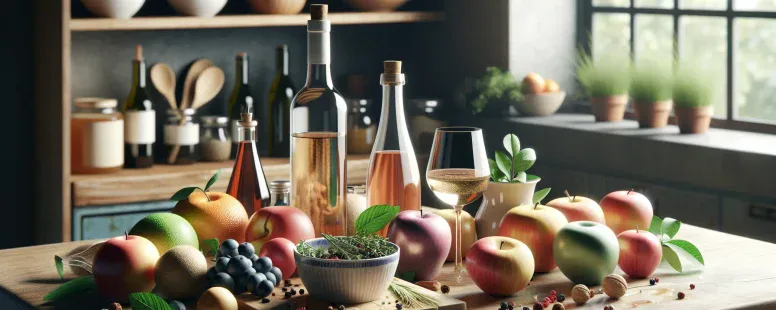Top 10 Best Substitute for Sherry in Cooking: Alcoholic & Non-Alcoholic Options
Picture this: you’re in the middle of preparing a recipe that calls for sherry, but your pantry comes up empty. That distinct, nutty-sweet flavor seems irreplaceable—until you realize there are plenty of creative substitutes waiting to save the day. Whether you’re crafting a savory sauce or adding depth to a dessert, finding the right alternative can be easier than you’d think.
What Is Sherry?
Sherry is a fortified wine originating from Spain, specifically the Andalusian town of Jerez de la Frontera. Its production involves fermenting white grapes, typically Palomino grapes, and aging them using a unique solera system. This process adds complex flavors and consistency across vintages.
The flavor profile of sherry spans from dry to sweet varieties. Dry options include Fino and Manzanilla, while cream sherries like Pedro Ximénez are rich and sweet. These variations make it versatile in cooking, enhancing sauces, marinades, soups, and desserts.
Sherry’s alcohol content ranges between 15% and 22%, depending on the type. Its distinctive nutty or caramelized undertones contribute depth to recipes when used as a deglazing liquid or flavor enhancer for meats and seafood.
Though primarily enjoyed as an aperitif or dessert accompaniment, sherry has historical significance in culinary traditions worldwide. Ancient civilizations valued it not just as a drink but also for its preservative properties in food preparation.
Why Substitute Sherry?
Using a substitute for sherry becomes essential when it’s unavailable or unsuitable for your needs. Whether enhancing sauces, soups, or desserts, alternatives ensure your recipe retains its intended flavor and depth.
Common Scenarios for Substitution
Running out of sherry mid-recipe is a common scenario. For example, you’re preparing a creamy mushroom sauce and realize there’s no sherry in the pantry. In such cases, you’d need replacements like dry white wine or apple cider vinegar to achieve comparable acidity and complexity.
Another instance involves cooking for children or individuals avoiding alcohol. Recipes calling for sweet sherries like Pedro Ximénez can often use grape juice with a touch of balsamic vinegar as a non-alcoholic option.
Substitutes are also needed when specific dietary preferences emerge. Vegan cooks might avoid sherries clarified with animal-based fining agents. They could opt instead for vegan-friendly wines or unfiltered apple juice.
Health and Dietary Restrictions
Sherry’s alcohol content makes it unsuitable for some diets or health conditions. If someone follows an alcohol-free lifestyle due to medical advice, ingredients like chicken stock combined with lemon juice offer similar savory richness without the ethanol content.
Individuals managing sugar intake may face challenges with sweet cream sherries in recipes like trifles or glazes. Reduced-sugar substitutes—like diluted pomegranate molasses—can work well here while keeping sweetness under control.
Cultural considerations sometimes dictate substitutions too; certain religious dietary laws prohibit alcoholic beverages altogether. In these contexts, flavorful broths or herbal teas serve as thoughtful replacements that respect restrictions while complementing dishes effectively.
Best Alcoholic Substitutes For Sherry
When sherry isn’t available, several alcoholic substitutes can replicate its depth and flavor in recipes. These options work well for both savory dishes and desserts.
Dry White Wine
Dry white wine delivers a similar acidity to dry sherry, making it an excellent substitute. Use varieties like Sauvignon Blanc or Pinot Grigio for light, crisp notes that seamlessly blend into soups, sauces, or marinades. For instance, adding 1/4 cup of dry white wine to a creamy mushroom sauce enhances the dish’s tanginess without overpowering other ingredients. Ensure you choose unsweetened wines to avoid altering the intended flavor balance.
Port or Madeira
Port and Madeira offer richer profiles compared to sherry but work effectively in recipes requiring sweet or nutty undertones. Ruby Port introduces fruity sweetness ideal for desserts like poached pears or chocolate sauces. In contrast, Madeira’s caramelized complexity complements savory reductions and gravies beautifully. Replace sherry with equal parts of these fortified wines while adjusting sugar levels if needed.
Non-Alcoholic Substitutes For Sherry
Non-alcoholic options can replicate sherry’s flavor profile and work well in various recipes. These alternatives cater to dietary preferences or restrictions without compromising taste.
Apple Cider Vinegar
Apple cider vinegar offers a tangy, slightly sweet flavor resembling dry sherry’s acidity. Use it in savory recipes like soups, stews, or marinades. Mix one tablespoon of apple cider vinegar with one tablespoon of water to dilute its sharpness before substituting for sherry.
For instance, if you’re preparing mushroom soup that calls for dry sherry, diluted apple cider vinegar enhances the dish by balancing richness with mild tartness. Its versatility also makes it ideal for deglazing pans or brightening salad dressings.
Grape Juice
White grape juice works as a non-alcoholic substitute due to its natural sweetness. Combine three parts white grape juice with one part balsamic vinegar for a closer match to the complex notes of sweet cream sherries like Pedro Ximénez.
This blend pairs perfectly with desserts such as bread pudding or fruit compotes where sweetness complements other ingredients. In savory dishes like glazed carrots, using this mixture creates depth while keeping the recipe alcohol-free.
Chicken Or Vegetable Broth
Chicken or vegetable broth provides umami flavors without alcoholic content and suits those avoiding sugar-rich substitutes. It’s particularly effective in hearty dishes such as casseroles or risottos where liquid consistency matters most.
Enhance broth-based substitutions by adding a splash of lemon juice for brightness or soy sauce for additional complexity. For example, replacing sherry in beef stew with vegetable broth and lemon retains bold flavors while respecting dietary choices.
Tips For Using Sherry Substitutes In Recipes
Finding the right sherry substitute ensures your recipes retain their intended flavors. Focus on balancing taste and texture when incorporating substitutes.
Adjusting Quantities
Match the quantity of your substitute to the recipe’s requirements for sherry. Use a 1:1 ratio in most cases, such as replacing dry sherry with dry white wine or apple cider vinegar diluted with water. But, adjust based on the intensity of the alternative. For example, balsamic vinegar’s robust flavor might overpower delicate dishes unless you dilute it further.
Consider reducing liquids elsewhere if using broths or juices to avoid overly watery results. Test small amounts first when unsure about how potent an ingredient might be in your dish.
Enhancing Flavor Profiles
Complement flavors by pairing substitutes with additional seasonings or ingredients. Add a splash of soy sauce or lemon juice to vegetable broth for extra umami when replacing sherry in savory recipes like soups or stews.
For desserts, mix grape juice with vanilla extract to mimic sweet sherries’ complexity. If using pomegranate molasses as a base, balance its tartness by incorporating honey or sugar syrup sparingly. Explore spices like cinnamon or nutmeg to create depth without altering the original recipe’s character too much.
Conclusion
Finding the perfect substitute for sherry doesn’t have to be a challenge. Whether you’re adapting for dietary needs, personal preferences, or simply running out of ingredients, there are plenty of versatile options to keep your dishes flavorful. From alcoholic alternatives like dry white wine and Madeira to non-alcoholic choices such as apple cider vinegar or broth, you can easily tailor your recipes without compromising taste.
Experimenting with these substitutes allows you to maintain the depth and balance that sherry brings while adding your own creative twist. With the right adjustments and enhancements, you’ll ensure every dish remains just as delicious and satisfying.
- Understanding the Difference Between Annulled and Divorced: Key Legal and Emotional Insights - October 30, 2025
- Ibuprofen vs. Aspirin: A Comprehensive Comparison - October 30, 2025
- The Difference Between Kosher Salt and Other Salts: Texture, Flavor, and Best Uses Explained - October 30, 2025







